Orınbayev Jumabay Tileubayevich
Assistant Professor, Department of Pathology, Karakalpakstan State Medical Institute, Uzbekistan
Correspondence to: Orınbayev Jumabay Tileubayevich, Assistant Professor, Department of Pathology, Karakalpakstan State Medical Institute, Uzbekistan.
Copyright © 2025 The Author(s). Published by Scientific & Academic Publishing.
This work is licensed under the Creative Commons Attribution International License (CC BY).
http://creativecommons.org/licenses/by/4.0/

Abstract
In pneumonia in infants up to one year of age, the normality of the immune system is maintained due to the integration of the morphologically formed adrenal gland and thymus. In pneumonia at 3-6 months of age, secondary immunodeficiency is observed due to the fact that hyperproduction of the adrenal gland depresses the thymus and prematurely causes apoptosis of the produced lymphocytes. In this case, hyperplasia of the adrenocortical zone and the appearance of foci of hemorrhage are sometimes manifested by adrenal insufficiency, which can lead to sudden death in infants. The formation of intermediate tumors in the adrenal gland tissues confirms the development of a hyperfunctional state of the adrenocortical and adrenocortical zones in this studied group.
Keywords:
Pathomorphology, Thymus, Adrenal gland, Pneumonia, Immunodeficiency, Depression, Immune system, Hyperfunctional state
Cite this paper: Orınbayev Jumabay Tileubayevich, Morphological Changes of the Adrenal Gland of Infants Who Died of Pneumonia Between the Ages of Six Months and One Year, American Journal of Medicine and Medical Sciences, Vol. 15 No. 4, 2025, pp. 982-986. doi: 10.5923/j.ajmms.20251504.28.
1. Introduction
In the world, pneumonia in infants under one year of age occurs on average at 8.2-9.75% per 1000 live births [1], due to intrauterine infections and nosocomial infections, as well as various influencing factors in the postnatal period. In developed countries, the USA and Europe, this figure is on average 4-5 per 1000 live births, and in the 3-6 month period, it is 11.72% per 1000 live births [2]. The highest rate in the world, in the period of newborns under 1 month, is in Turkmenistan, one of the Central Asian countries, with 45 cases per 1000 live births, while in our country this figure is 16 cases per 1000 live births [3]. This indicates that the full screening of extragenital diseases during intrauterine development or the tests that should be performed during pregnancy have not been fully implemented. Death in early infancy mainly develops in conjunction with infectious and non-infectious etiological processes, and is manifested in the morphological aspects of the integral connection of the adrenal gland and thymus in pneumonia of various etiologies in infants.Namely, the high mortality rate from pneumonia in the period up to 1 year of age, the incomplete implementation of screening and preventive work in the first and second link systems that monitor pregnant women, and the neglect of maternal and child protection, and the lack of specific scientific and practical recommendations and evidence-based medical recommendations during this period, and this process requires the need for constantly updated scientific and practical recommendations, once again confirming the urgency of the problem.
2. The Purpose of the Study
To study the pathomorphological characteristics of the adrenal gland in children who died from pneumonia in the neonatal period and died with a diagnosis of pneumonia.
3. The Materials and Methods
The materials and methods of the study were the autopsy medical documents, adrenal gland and thymus tissue of 101 infants who died with a diagnosis of pneumonia in the Republic of Karakalpakstan in 2020-2023. The thymus tissue of infants who died with a diagnosis of pneumonia was analyzed using the morphological method.
4. Results and Discussion
It should be noted that in this group of infants, the thymus and adrenal glands developed in direct proportion to each other due to the age-related morphological formation and the mutual integrative function of these two organs [4]. The adrenal glands in the group from 6 months to 12 months had the following weights:left – 2.46±0.15 g.; right – 2.63±0.15 g.The average weight of both adrenal glands was 5.10±0.30 g., i.e., lower than the age-related norm. However, the relative weight of the adrenal glands to body weight was higher (0.00086±0.00006) than the norm (0.00060±0.00001), and this difference was statistically significant (p<0.05).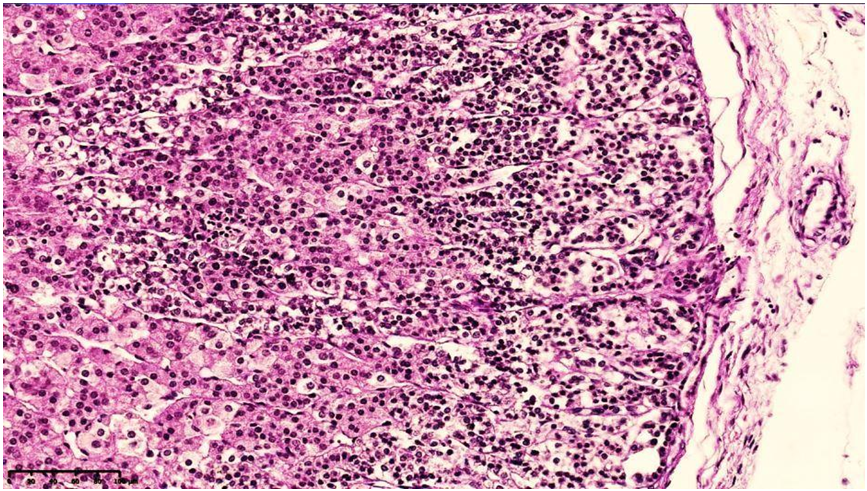 | Figure 1. Adrenal gland of an 8-month-old infant who died of pneumonia, protocol 21 DI. Morphologically mature adrenal cortex. The glomerular layer is hypercellular, with sparse fibrous structures at the perimeter of the developing glomerular structures (1). In the spongiotic zone, spongiocytes of various sizes are present, and the largest ones are cells rich in vacuolar dystrophy and homogeneous pink eosinophilic inclusions (2). Stained with G.E. Size 10x10 |
In the histological examination of the adrenal glands, fullness of the capillaries of the cortex layer, a decrease in the amount of lipids, a high level of RNA in the cells of the tufted zone, vacuolization and lysis of some cells are determined.The level of cortisol is 3235±527 nmol/l (normally 390±90 nmol/l), which means that it has increased 8 times.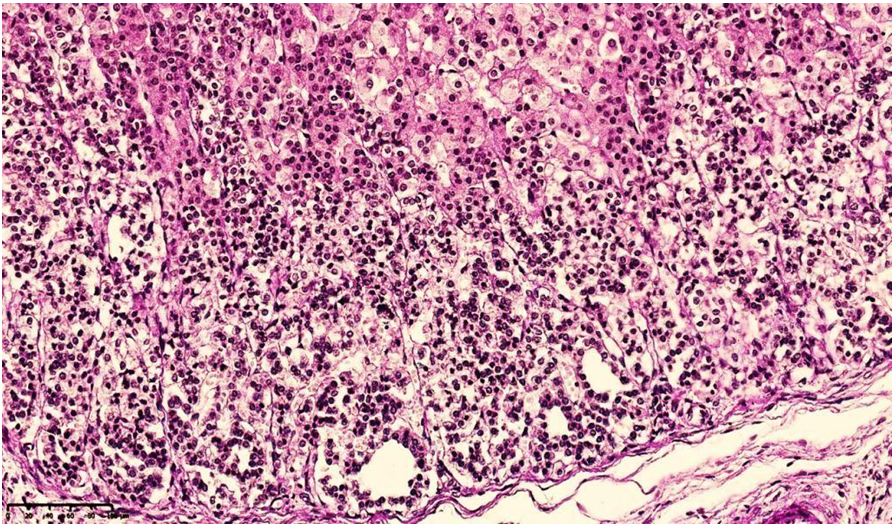 | Figure 2. Adrenal gland of a 10-month-old infant who died of pneumonia Report 56DI.. Morphologically determined adrenal cortical layer. The glomerular layer is hypercellular, and sparse fibrous structures are detected at the perimeter of developing glomerular structures (1). Paint G.E. The size is 10x10 |
Studies of the submicroscopic structure of the cells of the ciliated zone of the adrenal cortex showed that they contain numerous mitochondria with sharply enlarged vesicular crystals. Vesicular structures with smooth membranes are well formed in the cytoplasm. Lipid granules are small, and are stored in a smaller amount in the cytoplasm.Morphometric studies of the adrenal cortex show that the width of the cortex is 0.30±0.02 s., while the width of the spheroidal zone is 0.05±0.02 s., the ciliated zone is 0.22±0.02 s., and the striated zone is 0.02±0.003 s.. It was noted that the width of the adrenal cortex has a certain relationship with the morphological state of the thymus.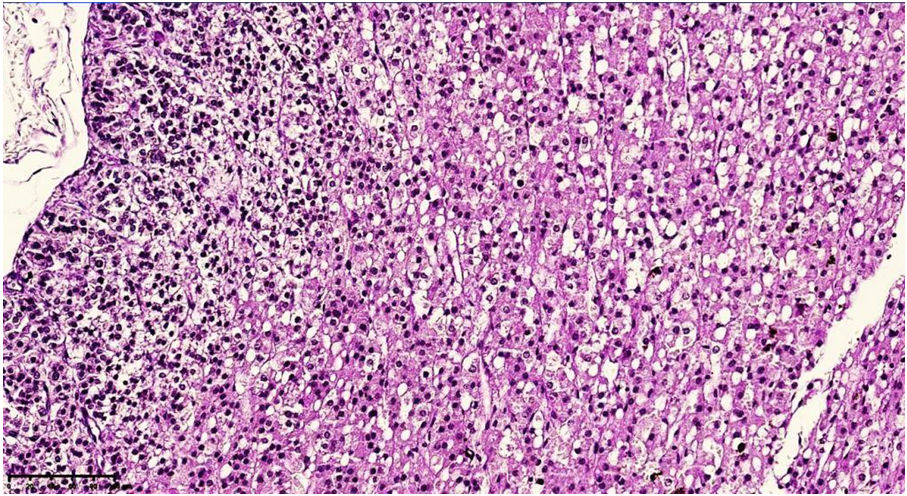 | Figure 3. Adrenal gland of a 12-month-old infant who died of pneumonia Report 55DI. In the area of the tumor, spongiocytes of various sizes are detected, the largest of which are rich in lipid inclusions and homogeneous pink eosinophilic inclusions (2). Staining GE. Size 10x10 |
Thus, the study of the morphofunctional state of the adrenal cortex in children of the III age group shows that the same direction of morphofunctional manifestations is preserved in this group, however, to some extent there is a tendency for the weakening of stressful tension from group I to group III.When studying the morphofunctional characteristics of the adrenal gland, hyperemia of the cortical layer, a decrease in protein in the cells of the zone of adhesion, an increase in RNA in them, hypertrophy of the nuclei, and cytolysis of some groups of cells were detected. The noted morphological appearance corresponds to the state of functional tension on the verge of exhaustion. When examining the adrenal gland in these children, its weight was 4.82±0.33 g.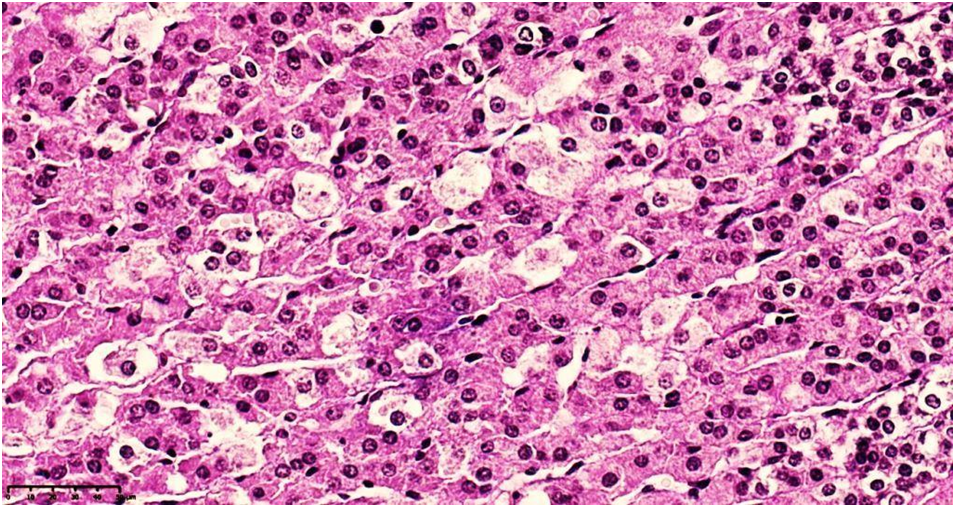 | Figure 4. Adrenal gland of an 11-month-old infant who died of pneumonia Report 55DI.. In the spongiotic area, spongiocytes of various sizes are detected, and the largest ones have undergone vacuolar dystrophy (1). Staining GE. Size 10x10 |
The weight of the adrenal gland in children with viral-bacterial pneumonia was 4.53±0.16 g. Morphological studies revealed hyperemia of the cortical layer of the gland accompanied by a very low protein content, high levels of RNA and hypertrophy of the nuclei of the cells of the zone of adhesion, the presence of a group of cells in a state of lysis. The noted morphological picture corresponds to the state of functional stress on the verge of exhaustion.In all three groups, similar changes were detected in the adrenal gland, with correlations between organ weight and cortisol levels [5,6]. Changes in the pituitary gland and adrenal gland indicate the state of the lung parenchyma: the prevalence of the lesion, as well as the degree of immunodeficiency, characterized by the occurrence of glucocorticoid-associated involution of the thymus, which is morphologically formed as a result of an 8-fold increase in cortisol compared to the norm. According to the analysis of morphological changes in our materials in group 3, the main morphological substrates are protein vacuolar dystrophy of spongiocytes in the cortical layer of the adrenal gland and massive accumulation of lipid inclusions in their cytoplasm, the formation of massive signs of complete blood loss in the capillaries of the interstitial sinusoids.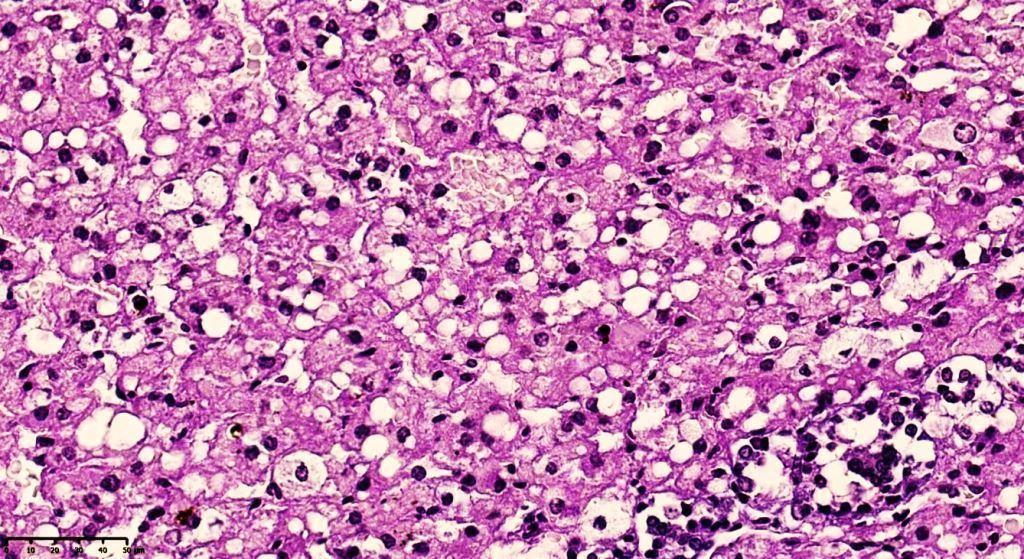 | Figure 5. Adrenal gland of a 12-month-old infant who died of pneumonia Report 55DI. In the tufted area, spangiocytes, cells rich in lipid inclusions of different sizes are identified (1). Dye G.E. The size is 10x10 |
Specifically, the cortical layer of the studied adrenal gland in 3 groups was morphologically developed, the capsule was of medium thickness, and weakly formed interstitial swellings were detected in the subcapsular areas. Gland epithelia forming the ball-shaped area are cuboidal, with hyperchromic nuclei, dark homogenous eosinophilic cytoplasm, and the stroma shows not-so-formed signs of fullness.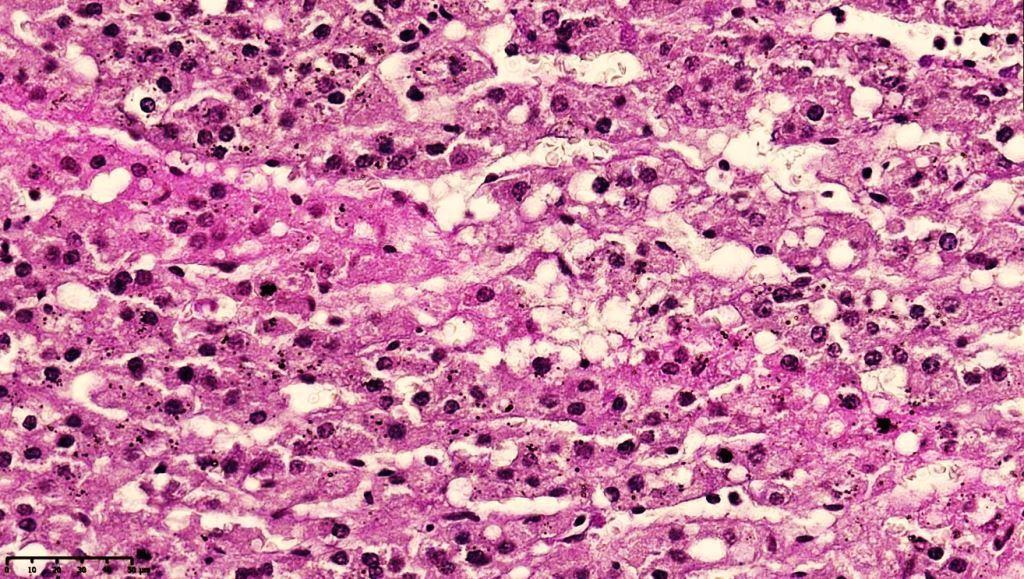 | Figure 6. Adrenal gland of a 12-month-old infant who died of pneumonia Report 55DI. Focal necrosis foci and advanced fibrotic tissue are detected in spangiocytes in the tufted area (1). Dye G.E. The size is 10x10 |
These morphological changes indicate that, unlike groups 1 and 2, there are no pronounced morphofunctional changes in the cortical layer of the spongiotic layer. In the stroma, sparse fibrous structures are located smoothly. Morphofunctional high activity is observed in the spongiotic layer: in the nuclei of spongiotic cells, rich in lipid inclusions, 5-8 pink homogeneous eosinophilic inclusions are detected in the 200x field of view, cells with an increase in volume of 1.7 times. This is explained by the formation of intermediate tumors on the perimeter of epithelial cells, and the presence of full-blooded perivascular vessels (see Fig. 4, 5, 6, 7).In the thymus tissue, one of the features characteristic of the group is the glucocorticoid-associated involution of morphologically mature thymic tissue [7]. In particular, the thymus fibrous capsule is thicker than usual, the vessels are full, the fragments are of various sizes, the number of prothymocytes around the subcapsular reticuloepitheliocytes is reduced, and areas of abundant destruction are detected in the stroma, which confirms the increased apoptosis process in small immature lymphocytes. 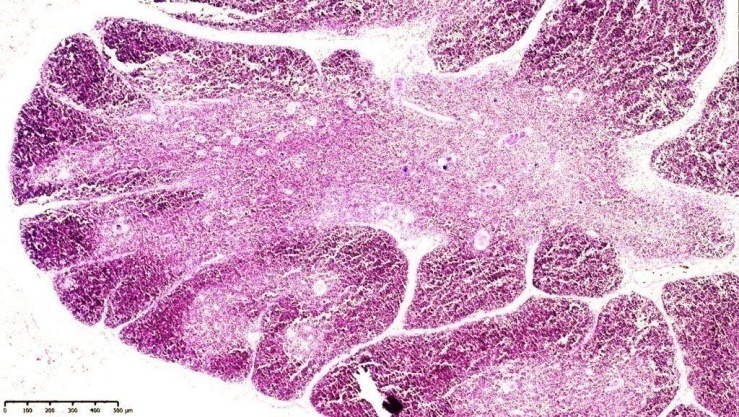 | Figure 7. 8-month-old baby diaper. The boundaries of the corticomedullary layers of the thymus cortex and medulla are clear, and small numbers of Gassal corpuscles are identified. Pieces of different sizes. Paint G.E. Size 4x10 |
The main structures in the medullary layer are developing Hassall bodies of various sizes, round, oval, some are Gantelsimon-shaped, with interstitial foci interconnected by sparse and coarse fibrous structures. This means that the thymus is not developed, with an increase in histiocytes and fibroblasts instead of reticuloepithelial cells in the medullary region, and foci of reticulocytosis and sclerosis [8]. The uneven saturation of small-caliber vessels in the medullary layer confirms the varying degrees of morphofunctional activity of the thymus.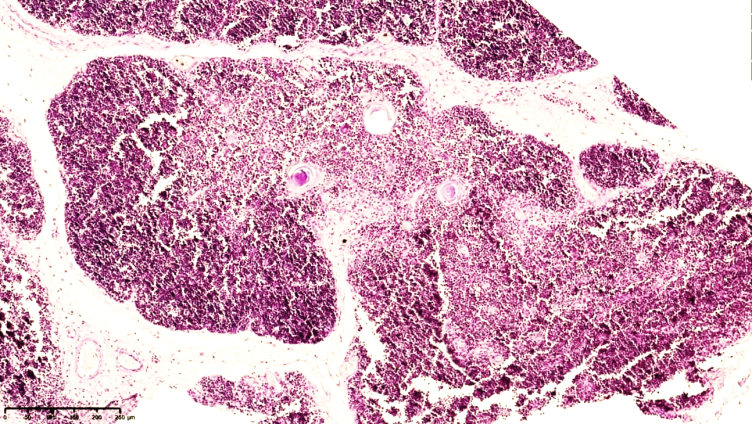 | Figure 8. An 11-month-old infant's salivary gland tissue. Fragments have decorticated foci. In the preserved fragment, the medullary layer is reduced and its borders are unclear. Paint G.E. Size 4x10 |
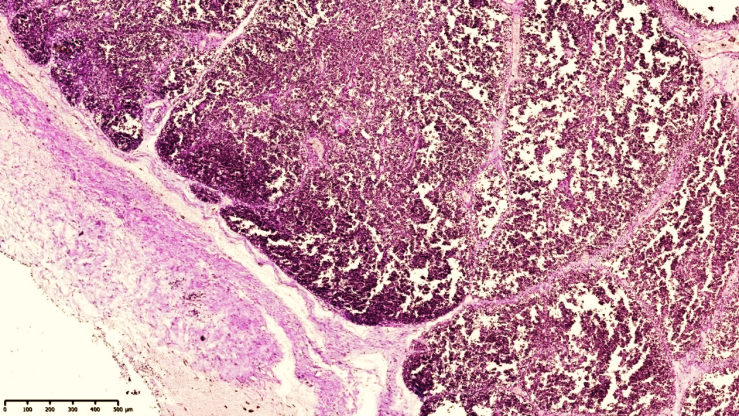 | Figure 9. Thymus tissue of a 12-month-old baby. Interlobular barrier fibrotic tissue is thickened. The boundaries of the medullary layer of the lobes are unclear and of different widths. The thymus capsule and thickened vessels appear plump. Paint G.E. Size 4x10 |
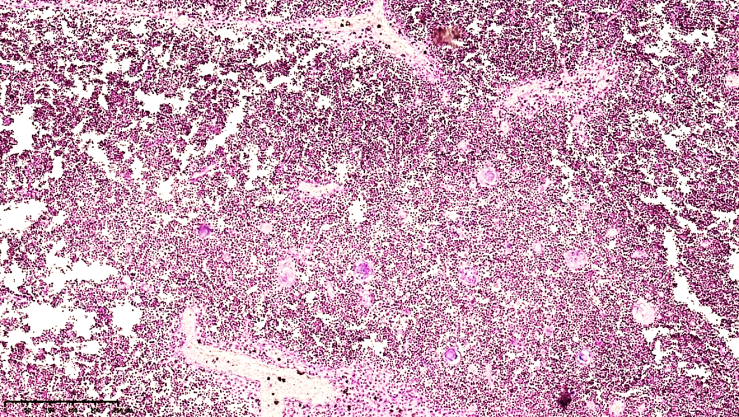 | Figure 10. A 12-month-old infant's salivary gland tissue. Gassal corpuscles of various sizes in the medulla, signs of fullness are detected in small-caliber blood vessels. Paint G.E. Size 4x10 |
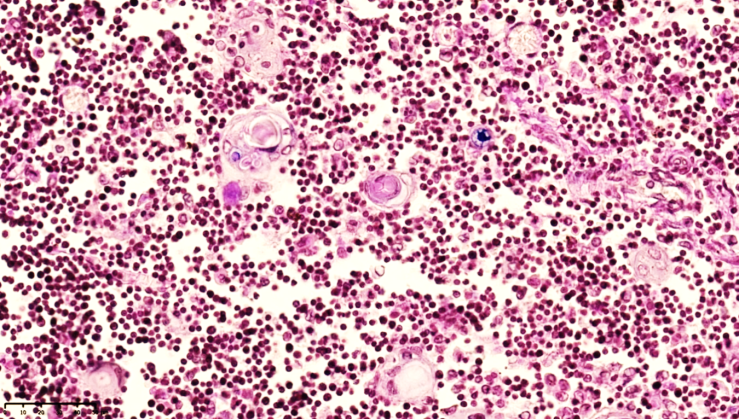 | Figure 11. A 12-month-old infant's salivary gland tissue. Foci of developing Gassal bodies, reticular and fibrous structures are identified in the medulla. Paint G.E. The size is 40x10 |
Thus, the morphological features of the thymus gland in group 3 are formed in comparison with the other groups and under the influence of stress factors, a decrease in the number of lymphocytes in the cortex and medulla layers, which have active areas, and uneven blood vessel filling are determined. It is characterized by a decrease in the medulla layer, thickening of the cortex layer, a decrease in the number of small lymphocytes to varying degrees.In particular, the preservation of signs of blood filling in the medulla layer, small-caliber blood vessels and capillaries, short and round growths of reticulo-epithelial cells, an increase in the number of sparse fibrous connective tissue foci around them, a small number of proliferatively multiplying prethymocytes in the cortex layer, and the presence of interstitial spaces. Although the corticomedullary border area is clear compared to groups 1 and 2, foci of the border with a wavy appearance are defined.
5. Conclusions
Thus, the number of mature lymphocytes in the cortical layer of the thyroid gland is small, the foci of apoptosis are massive, the postcapillary venules are full, interstitial tumors are formed in the intermediate stroma, macrophages are mainly located on the perimeter of reticuloepithelial cell growths, and a large number of small lymphocytes are found. The medullary layer is characterized by a sharp decrease in lymphocytes around reticuloepithelial cells, dendritic cells, and reticular cells, and the presence of Hassall bodies of various sizes, and in the focus of reticuloepithelial cells, vacuolar dystrophy, and some of them are of various shapes due to protein dystrophy.
References
| [1] | Avanesyan H.A., Berlai M.V., Kopylov A.V. et al. Forensic diagnostics of morphological changes in sudden infant death syndrome // Medical Bulletin of the North Caucasus. 2018. No. 4. –P. 667. |
| [2] | Zernova L.Yu., Kovalenko T.V. Features of hormonal adaptation of newborns with extremely low body weight // Works of the Izhevsk State Medical Academy. - 2016. - P. 113-115. |
| [3] | Anvarov Zh.A., Nurimov P.B. Analysis of functional changes in the pituitary gland and adrenal glands in COVID-19. - 2022. -repository.tma.uz. |
| [4] | Koroid N.V., Zaplatnikov A.L., Mingalimova G.A., Glukhareva N.S. Community-acquired pneumonia in children: diagnosis and treatment. RMJ. 2015; 22: 1365–1370. |
| [5] | Webb E.A., Krone N. Current and novel approaches to children and young people with congenital adrenal hyperplasia and adrenal insufficiency // Best Pract. Res. Clin. Endocrinol. Metab. 2015. Vol. 29, № 3. P. 449-468. |
| [6] | Ibraeva L.R. et al. Assessment of the epidemiological risk of organizing inpatient treatment for community-acquired pneumonia in children // Journal of MediAl. - 2018. - No. 1 (21). - P. 24-26. |
| [7] | Zarnitsyna N.Yu., Kurnosov Yu.V., Podluzhnaya M.A. Thymomegaly imitating thymoma as a factor contributing to the development of severe pneumonia in a newborn // V- Pichugin Readings. Actual problems of modern pediatrics. - 2017. - P. 411-415. |
| [8] | Kamali M., Oquendo M.A., Mann J.J. Understanding the neurobiology of suicidal behavior // Depress Anxiety. - 2001. - Vol. 14 (3). - P. 164-176. |





 Abstract
Abstract Reference
Reference Full-Text PDF
Full-Text PDF Full-text HTML
Full-text HTML






